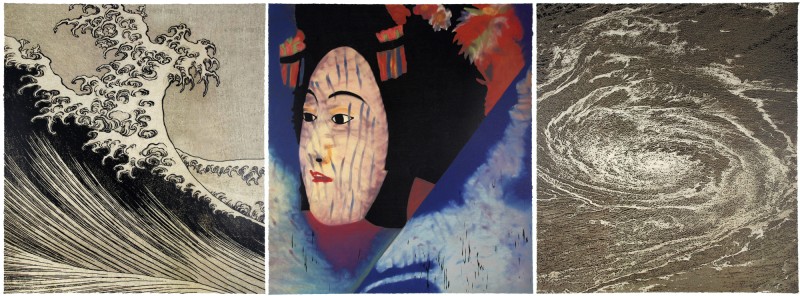
woodcut with acrylic
25.5 x 23 in. each
edition of 16
Rupert Garcia’s Tsunami combines one of the most venerated traditional printmaking techniques, the woodcut, with the precision and boundless color possibilities of the digital age. The work has antecedents in Garcia’s iconic Frida Kahlo woodcut of 2002 and the many mixed-media works he has produced at Magnolia Editions in subsequent years, as demonstrated in 2011’s “Rupert Garcia: the Magnolia Editions Projects 1991-2011” exhibition at San Francisco’s de Young Museum. Garcia continues to refine his balance of digital and traditional media to create works that apply his mastery of color and form toward a philosophical consideration of world history.
Garcia’s work is often topical, taking inspiration from contemporary events or drawing connections between historical figures and situations. Here his imagery evokes the Touhoku earthquake and tsunami which devastated eastern Japan in 2011, the most destructive natural disaster in the country’s history. In addition to the emotional and economic impact of the earthquake on human beings the world over, fundamental aspects of life on Earth such as the length of a day and the tilt and speed of the Earth’s rotation were changed by this event. In addressing the tsunami, Garcia has drawn from the traditional art forms of Japan, basing the left- and right-hand panels on details from Japanese woodblock prints of waves and water. The center panel is based on an earlier Garcia painting, Bunraku, depicting a figure from the world of Japanese puppet theater. The elegant, warm swells of color in the center panel are cloudlike and delicate but assertively vibrant: a breath of refined life in the midst of the tsunami’s menace.
Traditional reductive woodcuts (like Garcia’s Frida Kahlo) are usually printed one color at a time, making the kind of gauzy color effects seen in Tsunami extremely difficult; however, it is also nearly impossible to create the textures and deep impression of a woodcut using only a typical inkjet process. Garcia achieved the combination of unmistakable wood block texture and minutely detailed color in Tsunami through a series of sophisticated procedures. First, the artist worked with Donald Farnsworth to convert his imagery into a digital file which can be output to a laser cutter. The laser was used to cut away non-image sections of a maple plywood block; the block was then further carved by hand by printer Sam Bennett at Magnolia Editions, using an electric drill. A layer of black ink was rolled onto the wood block and printed on archival cotton rag paper. Each black-and-white print on paper was then carefully registered by printer Tallulah Terryll on a UV-cured acrylic printer, which lays down archival acrylic inks and then immediately exposes them to ultraviolet light, converting the liquid ink to a solid form instantly. This printer was used to layer acrylic colors over the black woodcut print, creating a final composition that is a unique hybrid of digital and traditional processes. By bridging the two realms, Garcia has found a best-of-both-worlds solution which may hold a clue as to what the printmaking of the future will look like.
-Nick Stone
show prices
Prices and availability are subject to change without notice.The copyright of all art images belongs to the individual artists and Magnolia Editions, Inc.
©2003-2025 Magnolia Editions, Inc. All rights reserved. contact us
